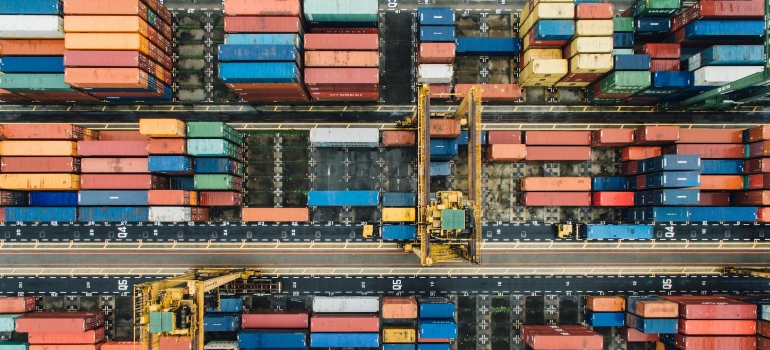Trends and Predictions for Idaho Commercial Shipping
Idaho’s commercial shipping sector, pivotal in the state’s economy, is undergoing a significant transformation. Global economic trends and local market conditions shape its current state. Hence, the focus should be on how Idaho’s commercial shipping industry is responding to these new challenges, including adapting to digital advancements and changing consumer behaviors. Hence, the operational complexities and predictions for Idaho commercial shipping are critical for both professionals and stakeholders. Understanding these aspects with assistance from Peasley Moving & Storage is essential for navigating the industry’s future and leveraging its potential for driving Idaho’s economic progress.
Historical Overview and Recent Trends in Idaho’s Commercial Shipping
Idaho’s commercial shipping industry has a rich history, deeply intertwined with the state’s economic development. Traditionally, the industry has been driven by Idaho’s strong agricultural sector, with commodities like potatoes, dairy products, and lumber forming the backbone of its shipping needs. Over the years, the industry has evolved, adapting to changes in market demands and technological advancements.
In the early days, Idaho’s commercial shipping relied heavily on rail and road networks. The state’s geographical location, landlocked and distant from major seaports, meant that efficient land transportation was crucial. However, as the economy diversified, the industry expanded its scope, embracing more varied cargo and integrating more advanced logistics solutions.
Recent Trends in Local Freight Trucking
The Local Freight Trucking report provides a snapshot of the industry’s current state. Despite facing a decline, with an expected decrease to $227.6 million over five years to 2024, the industry remains a significant player in Idaho’s economy. This decline is reflective of broader national trends but is influenced by local factors such as changes in the agricultural sector and the rise of e-commerce.

The number of businesses within the industry has seen growth, indicating a fragmented market with numerous small players. Yet, this fragmentation presents both challenges and opportunities. On the one hand, it fosters competition and innovation; on the other, it can lead to inefficiencies and a lack of coordination in the logistics chain.
Economic Changes Impacting the Industry
Idaho’s economy has undergone significant changes in the past decade, influencing the commercial shipping industry. The state’s population boom, with an increase of 343,000 residents from 2012 to 2022, has led to a surge in demand for goods and services. This demographic shift has impacted the labor market, with the civilian labor force increasing by 23.1%, thereby influencing the demand for commercial shipping services.
The rise of e-commerce has been another major factor shaping recent trends. As consumer preferences shift towards online shopping, the demand for efficient and reliable shipping solutions has skyrocketed. This shift has prompted the industry to adapt, focusing more on small parcel deliveries and last-mile logistics.
Idaho’s commercial shipping industry, particularly the local freight trucking sector, reflects the state’s economic resilience and adaptability. While facing challenges such as market decline and industry fragmentation, it continues to evolve, shaped by economic changes and technological advancements. Understanding this historical context and recent trends is crucial for stakeholders looking to navigate the future of this vital industry.
Current State of Freight Infrastructure in Idaho
Idaho’s freight infrastructure, including freight shipping Boise companies, is a critical component of its economy, facilitating the movement of goods across the state and beyond. The infrastructure encompasses a network of highways, railroads, airports, and trucking routes that collectively support the state’s commercial shipping needs.
Highway and Road Networks
The backbone of Idaho’s freight infrastructure is its extensive highway and road network. Major highways, including interstates like I-84 and I-90, play a pivotal role in connecting Idaho with neighboring states and key commercial centers. More, these highways are crucial for the efficient movement of goods, especially for industries such as agriculture and manufacturing that rely heavily on road transport.

Rail Transport
Rail transport is another key component of Idaho’s freight infrastructure. The state’s rail network connects it to major national rail systems, providing a vital link for the transport of bulk commodities. This network is particularly important for transporting Idaho’s agricultural products, minerals, and timber to markets across the country.
Air Freight
Air freight, though less prominent than road and rail, is an essential part of Idaho’s freight infrastructure. The state’s airports, including Boise Airport and Spokane International Airport, offer cargo services that are crucial for time-sensitive shipments, door-to-door international shipping, and high-value goods.
Trucking Industry
The trucking industry remains the linchpin of Idaho’s freight infrastructure. Also, it offers flexibility and last-mile connectivity that other modes of transport cannot match. The industry, as detailed in the Local Freight Trucking report, is experiencing changes in market size and business dynamics, reflecting broader trends in the economy and consumer behavior.
Challenges and Opportunities
Idaho’s freight infrastructure faces several challenges, including maintaining and upgrading aging infrastructure, adapting to technological advancements, and meeting the evolving needs of a growing economy. However, these challenges also present opportunities for improvement and innovation. Investments in infrastructure modernization and embracing new technologies like autonomous vehicles and advanced logistics systems can significantly enhance the efficiency and capacity of freight companies in Idaho and their network.
The current state of Idaho’s freight infrastructure is a complex interplay of various transport modes, each playing a vital role in supporting the state’s economy. While challenges exist, there are significant opportunities for growth and enhancement. Understanding and investing in this infrastructure is crucial for the continued success of Idaho’s commercial shipping industry.

Freight Data and Supply-Chain Analysis in Idaho
Idaho’s freight data sheds light on how goods move across the state. This information is crucial for businesses and policymakers to make predictions for Idaho commercial shipping and informed decisions. It tells us what kinds of goods are being transported, how much they weigh, their value, and how they’re getting from point A to point B:
- Types of Goods Transported: Idaho moves a variety of goods, but some of the most common include agricultural products like potatoes and dairy, as well as manufactured goods.
- Modes of Transportation: The data shows how goods are transported, whether by truck, train, airplane, or even pipelines. Trucks are the most common mode of transportation, but rail and air transport play significant roles, too.
- Movement Patterns: This part of the data tells us about the main routes used for transporting goods. It helps identify busy areas that might need more infrastructure support.
In essence, Idaho’s freight data highlights the diversity of goods transported, the reliance on multiple transportation modes, and the importance of understanding movement patterns. This information is crucial for optimizing the state’s commercial shipping infrastructure and supporting its economic growth.
Supply-Chain Logistics Analysis
On the other hand, supply-chain logistics is all about how goods are moved from the producers to the consumers. It’s a complex process, and analyzing it helps improve efficiency and reduce costs:
- Logistics Efficiency: This involves looking at how quickly and reliably goods are moving. Are there delays? Are goods arriving on time? This part of the analysis helps identify any problem areas in the transportation process.
- Connecting Different Transport Modes: It’s important that goods can move smoothly from trucks to trains or planes as needed. This part of the analysis looks at how well these different modes work together.
- Technology’s Role: Modern technology like GPS tracking and automated systems can make a big difference in how efficiently goods are moved. This analysis looks at how well Idaho is using these technologies.
Understanding Idaho’s freight data and supply-chain logistics is key to keeping the state’s economy moving smoothly. Looking at what’s being transported, how it’s getting around, and where the system can improve, Idaho can ensure that its businesses and consumers get what they need when they need it.
Economic Impact and Labor Market in Idaho: The Role of Commercial Shipping
Predictions for Idaho commercial shipping play a pivotal role in Idaho’s economy, significantly influencing both the state’s financial health and its labor market. This sector, integral to the movement of goods, directly impacts various industries and employment opportunities within the state.
Driving Economic Growth
Commercial shipping is a major contributor to Idaho’s economic growth. It facilitates the efficient movement of goods, which is essential for the state’s predominant industries like agriculture, manufacturing, and retail. Idaho’s container shipping companies and commercial shipping boost trade and commerce, ensuring that products like Idaho’s famous potatoes and dairy goods reach markets efficiently. This sector’s efficiency directly affects the state’s ability to attract and retain businesses, making it a key factor in economic development.
Supporting Diverse Industries
The ripple effect of a robust commercial shipping sector is felt across multiple industries. It not only supports primary sectors like agriculture and manufacturing but also bolsters secondary services such as warehousing, logistics, and retail. Furthermore, these industries rely on the timely and efficient transport of goods, which in turn creates a demand for a variety of jobs and skill sets.

Impact on the Labor Market
Commercial shipping significantly influences Idaho’s labor market. The sector creates a range of employment opportunities, from truck drivers and warehouse staff to logistics managers and supply chain analysts. As the industry adapts to technological advancements and changing market demands, it also fosters a dynamic labor market that requires a diverse range of skills and expertise. This adaptability has been crucial, especially in response to the recent surge in e-commerce, which has increased the demand for shipping and logistics services.
Future Predictions and Industry Outlook for Idaho’s Commercial Shipping
Looking ahead, Idaho’s commercial shipping industry is poised for significant changes, shaped by evolving market demands and technological advancements. Insights from the Tugboat & Shipping Navigational Services report suggest several potential growth areas and challenges that could redefine the industry’s future:
- E-commerce Expansion: The continued rise of online shopping is expected to drive growth in the shipping and logistics sector. This trend will likely increase the demand for efficient last-mile delivery services.
- Technological Advancements: Innovations in technology, like automation and AI in logistics, can enhance efficiency and reduce operational costs. The adoption of these technologies could be a game-changer.
- Sustainable Practices: There’s a growing emphasis on sustainability in shipping. This shift could lead to increased investment in electric trucks and green logistics.
However, there are important challenges to address:
- Infrastructure Upgrades: Keeping up with the increasing demand for shipping services will require significant upgrades to Idaho’s freight infrastructure. This includes modernizing roads, bridges, and ports to handle larger volumes of goods more efficiently.
- Workforce Development: As the industry evolves, there will be a need for skilled professionals who can manage and operate advanced logistics systems. Developing a workforce capable of handling these new challenges will be crucial.
- Regulatory Compliance: Navigating the complex web of regulations, both at the state and federal levels, will continue to be a challenge for the industry. Also, compliance with environmental regulations and safety standards will be particularly important as the industry grows.
The future of Idaho’s commercial shipping industry looks promising, with significant opportunities for growth and innovation. However, realizing this potential will require addressing key challenges, particularly in infrastructure development, workforce training, and regulatory compliance. Idaho’s shipping industry can continue to be a vital contributor to the state’s economy by staying ahead of these challenges and capitalizing on emerging trends.
Driving the State’s Economic Growth and Development
As the industry stands at the crossroads of significant evolution, predictions for Idaho commercial shipping indicate a future marked by both challenges and opportunities. This vital sector, a cornerstone of the state’s economy, is ready to navigate dynamic changes, leveraging advancements in technology and shifts in market demands. From its historical roots to the present-day landscape, each facet of the industry reveals potential for growth, adaptation, and potential.
The coming years are expected to bring a surge in e-commerce, technological innovation, and a heightened focus on sustainability, all of which will shape the industry’s trajectory. The rise of e-commerce, advancements in technology, and a growing emphasis on sustainability are reshaping the industry. Therefore, Idaho must navigate these changes with strategic investments in infrastructure, workforce development, and regulatory compliance to maintain its competitive edge.

Everyone from the packers to the movers were awesome! They were all very professional and showed up when they were supposed to. would definitely use them again.

